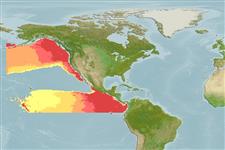>
Lophiiformes (Anglerfishes) >
Oneirodidae (Dreamers)
Etymology: Oneirodes: Greek, 'oneiros' = a dream or dreamlike or out of a dream (suggesting this fish is so strange and marvelous that can exist only in dreams) (Ref. 86949).
Environment: milieu / climate zone / depth range / distribution range
Écologie
marin bathypélagique; profondeur 700 - 1400 m (Ref. 86949). Deep-water
Eastern Central Pacific: Mexico.
Taille / Poids / Âge
Maturity: Lm ? range ? - ? cm
Max length : 15.9 cm SL (female)
Description synthétique
Clés d'identification | Morphologie | Morphométrie
Rayons mous dorsaux (Total) : 5 - 6; Rayons mous anaux: 4. Characterized by having escal morphology: esca with filamentous, branched anterior appendage two times length of escal bulb, without internal pigment; presence of spots of dark pigment on most branches of anterior appendage; absence of medial escal appendage; rounded or conical terminal escal papilla with two bilaterally placed distal spots of pigment; posterior escal appendage, as long as escal bulb, with an anteroposteriorly compressed distal end, posterior surface of which is slightly concave and darkly pigmented; absence of lateral escal appendage; two pairs of filamentous anterolateral escal appendages; inner pair of branched tapering appendages flanking anterior appendage, each less than one-half length of escal bulb; long and narrow subopercle, dorsal end tapering to a point, without indentation on posterodorsal margin; length of ventral fork of opercle 25.3-28.6% SL; ratio of lengths of the dorsal and ventral forks of opercle 0.54-0.62; absence of epibranchial teeth; presence of teeth on pharyngobranchial II; upper jaw teeth 49-69, lower jaw teeth 46-60; teeth on vomer 4-8; dorsal fin rays 5-6; anal fin rays 4; pectoral fin rays 15-16; head length 38.9-43.4% SL; head depth 37.7-41.7% SL; premaxilla length 32.2-33.3% SL; length of lower jaw 42.1-44.3% SL; length of illicium 45.9-51.6% SL (Ref. 86949).
Life cycle and mating behavior
Maturities | Reproduction | Spawnings | Egg(s) | Fecundities | Larves
Orr, J.W., 1991. A new species of the ceratioid anglerfish genus Oneirodes (Oneirodidae) from the western North Atlantic, with a revised key to the genus. Copeia 1991(4):1024-1031. (Ref. 36336)
Statut dans la liste rouge de l'IUCN (Ref. 130435)
Menace pour l'homme
Harmless
Utilisations par l'homme
Outils
Articles particuliers
Télécharger en XML
Sources Internet
Estimates based on models
Preferred temperature (Ref.
123201): 3.3 - 4.1, mean 3.7 °C (based on 16 cells).
Phylogenetic diversity index (Ref.
82804): PD
50 = 0.5000 [Uniqueness, from 0.5 = low to 2.0 = high].
Bayesian length-weight: a=0.01995 (0.00906 - 0.04395), b=3.01 (2.83 - 3.19), in cm total length, based on all LWR estimates for this body shape (Ref.
93245).
Niveau trophique (Ref.
69278): 4.2 ±0.7 se; based on size and trophs of closest relatives
Résilience (Ref.
120179): Milieu, temps minimum de doublement de population : 1,4 à 4,4 années (Preliminary K or Fecundity.).
Fishing Vulnerability (Ref.
59153): Low vulnerability (10 of 100).
